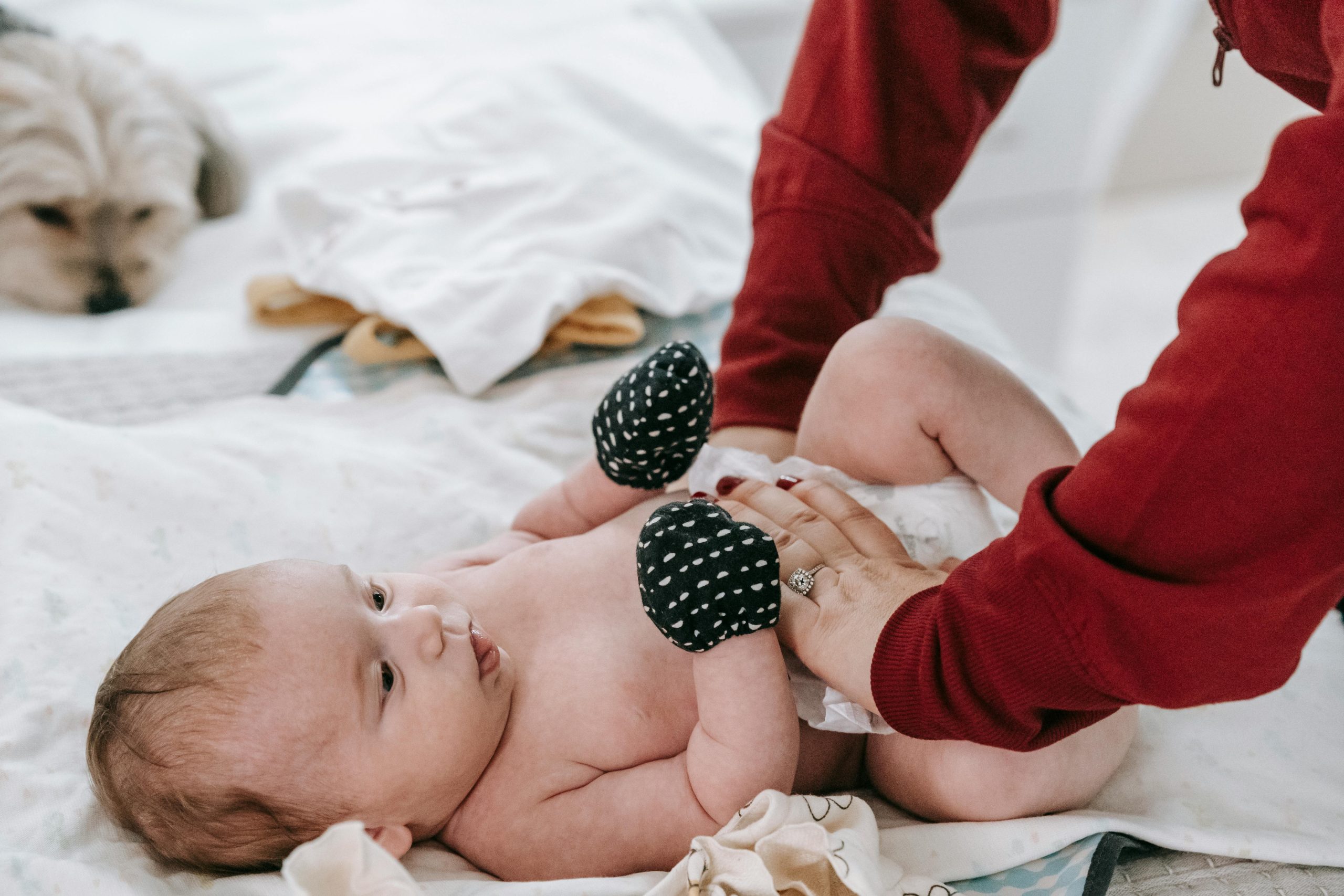Guide On How To Change A Baby’s Diaper:
Learning how to change a baby’s diaper is an essential skill for every new parent or caregiver, and while it may seem daunting at first, with practice and patience, it will soon become part of your daily routine. This comprehensive guide offers a step-by-step process on changing a baby’s diaper, emphasizing the importance of safety, hygiene, and comfort throughout each stage.
Gathering Supplies:
- Diapers: Choose the right size and type (disposable vs. cloth) based on your baby’s needs and preferences. Consider having different sizes readily available for changes throughout the day or growth spurts.
- Wipes: Opt for hypoallergenic, fragrance-free wipes to minimize irritation. Consider warming them slightly for increased comfort.
- Changing Pad: Ensure the pad is clean, comfortable, and waterproof to protect surfaces and prevent leaks. A changing table with storage for supplies can be convenient but isn’t essential.
- Barrier Cream (Optional): Use a zinc oxide-based cream to create a protective barrier against wetness and prevent diaper rash, especially after messy changes or prolonged diaper wear.
- Warm Water (Optional): A basin of warm water and washcloth can be helpful for stubborn messes or sensitive skin.
- Disposal Bin: Have a designated bin with a lid readily available for soiled diapers and wipes. Consider eco-friendly disposal options if using disposable diapers.
Changing Process:
- Lay Baby Down: Gently place your baby on their back on the changing pad. Secure them with one hand to prevent rolling.
- Remove the Soiled Diaper: Unfasten the tabs and carefully lift the diaper away from the body, folding it inwards to contain mess. Dispose of it appropriately.
- Cleanse the Area: Using warm water and gentle wipes, thoroughly clean the genital area, buttocks, and folds, moving front to back to prevent spreading bacteria. Use a separate wipe for each area. Pat dry with a soft towel.
- Apply Barrier Cream (Optional): For diaper rash prevention, apply a thin layer of hypoallergenic barrier cream to clean, dry skin.
- Position the New Diaper: Slide the clean diaper under your baby’s bottom, aligning the tabs with the front and back.
- Fasten Securely: Pull the tabs snugly but comfortably around the waist, ensuring a good fit without leaving red marks. Adjust leg cuffs for a leak-proof seal.
- Wash Hands Again: Clean your hands thoroughly with soap and water to prevent spreading germs.
Finding a Clean, Safe Space:
- Comfort and Accessibility: Choose a well-lit area with enough space for movement and easy access to supplies. A changing table provides comfort and organization, but any clean, safe surface like a bed or the floor can work.
- Temperature Control: Ensure the room is comfortably warm to avoid chilling your baby during the change.
- Minimize Distractions: Avoid changing near loud noises or distractions that might startle your baby.
- Washing Your Hands Thoroughly:
- Hand Hygiene is Key: This is the most crucial step in preventing the spread of germs between you and your baby. Use warm water and soap, lathering for at least 20 seconds, reaching all surfaces of your hands and under your nails. Rinse thoroughly and dry with a clean towel.
- Hand Sanitizer (Optional): If soap and water aren’t readily available, use an alcohol-based hand sanitizer with at least 60% alcohol as a backup. Still consider washing your hands with soap and water as soon as possible afterward.
Additional Tips:
- Distract Your Baby: Use toys, songs, or gentle talk to keep your baby entertained and calm during the process.
- Respond to Cues: Watch for signs of discomfort or fussiness, and adjust your actions accordingly.
- Handle Poop: Scrape off excess with a disposable diaper liner or wipe before cleaning. Use separate wipes for feces to avoid spreading germs.
- Double Diapering (Optional): For heavy wetters at night, consider using two diapers for extra absorbency.
- Diaper Rash: If you notice redness or irritation, consult your pediatrician for diagnosis and treatment recommendations.
Deep-Dive Exploration on Diaper Changing:
1. Detailed Videos:
Newborn Diaper Changing:
-
- Focus: Specific techniques for handling fragile skin, umbilical cord care, and managing smaller size.
- Additional points: Calming strategies for newborns, positioning tips, and signs of a good fit.
Cloth Diapering Basics:
-
- Focus: Types of cloth diapers, washing routines, troubleshooting leaks, and cost comparison.
- Additional points: Benefits and drawbacks of cloth diapering, eco-friendly choices, and resources for support groups.
Handling Blowouts:
-
- Focus: Quick cleaning methods, minimizing mess, and preventing future blowouts.
- Additional points: Choosing the right size and absorbency, managing poop consistency, and diaper rash prevention strategies.
Premature Baby Diapering:
-
- Focus: Specialized techniques for delicate skin, positioning considerations, and monitoring for infection risk.
- Additional points: Working with medical professionals, using preemie-specific diapers, and emotional support for caregivers.
2. Specific Needs:
Cloth Diaper Washing Guide:
-
- Focus: Different washing routines for various fabrics, troubleshooting detergent build-up, and optimizing efficiency.
- Additional points: Eco-friendly washing practices, dealing with hard water, and stain removal tips.
Diaper Rash Resources:
-
- Focus: Identifying different types of rashes, safe and effective treatment options, and preventing recurrence.
- Additional points: Role of diet, sensitivity to wipes or diapers, and consulting a healthcare professional for persistent rash.
Special Needs Diapering Guide:
-
- Focus: Specific challenges and adaptations for babies with disabilities or medical conditions.
- Additional points: Choosing appropriate diaper types, ensuring comfort and accessibility, and resources for specialized care.
3. Diaper Disposal:
Eco-Friendly Diapers:
-
- Focus: Comparing different eco-friendly diaper options like cloth, compostable, and hybrid types.
- Additional points: Assessing environmental impact, availability and cost considerations, and disposal challenges.
Disposable Diaper Recycling:
-
- Focus: Programs and facilities offering disposable diaper recycling near you.
- Additional points: Understanding the recycling process, preparing diapers for collection, and limitations of available options.
Landfill Disposal Guidelines:
-
- Focus: Proper disposal methods to minimize environmental impact in areas without recycling options.
- Additional points: Reducing diaper waste through mindful purchasing and cloth diapering alternatives.
4. Additional Topics:
Diaper Dermatitis Research:
-
- Focus: Latest findings on causes, risk factors, and potential preventative measures for diaper rash.
- Additional points: Exploring potential links to diet, microbiome, and genetic factors.
Environmental Impact of Diapers:
-
- Focus: Comparing the environmental footprint of different diaper types throughout their lifecycle.
- Additional points: Sustainable practices in diaper production, disposal, and research for future solutions.
History of Diapers:
-
- Focus: From ancient cloth wraps to modern disposable options, exploring the evolution of diaper technology.
- Additional points: Cultural influences, economic factors, and impact on hygiene and child development.
Remember, every baby is different. Adapt these guidelines based on your baby’s individual needs and comfort level. Don’t hesitate to consult your pediatrician if you have any specific questions or concerns.





